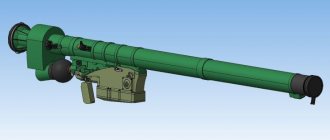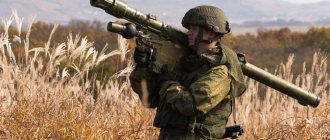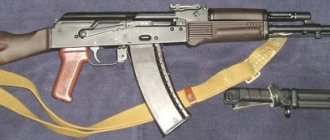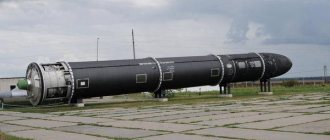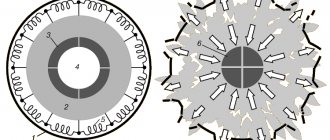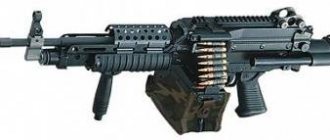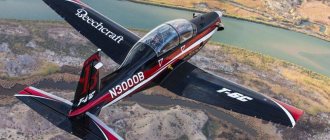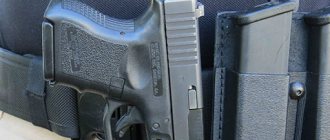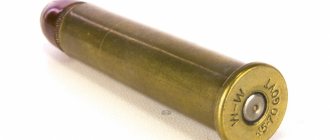Man-portable anti-aircraft missile systems (MANPADS) are a fairly young type of weapon. MANPADS are difficult to develop and manufacture, so there are not many models and they are produced only in some countries. However, among them there was (and still is) an installation that for a long time was the most famous representative of the class.
Just as “Bazooka” for some time became the collective name for all anti-tank grenade launchers, portable anti-aircraft missiles were associated specifically with the “Stinger”. Now, of course, the Stinger is no longer the most famous and effective system - but it remains one of the most common models.
Creation and development of Stinger MANPADS
In the American army, until the mid-70s, the main air defense system for infantry units was the FIM-43 Redeye MANPADS.
However, with the increase in the flight speed of attack aircraft and the appearance of armor elements on aircraft, more advanced weapons were required. The emphasis was placed on improved technical characteristics of the anti-aircraft missile. The development of a new air defense system was undertaken by the American one. The design work, which began back in 1967, lasted for seven long years. It was only in 1977 that the design of the future new generation MANPADS was finally outlined. This long delay is explained by the lack of technological capabilities to create a missile thermal guidance system, which was supposed to be the highlight of the new anti-aircraft missile system. The first prototypes entered testing in 1973, but their results were disappointing for the designers. The launcher was large and required an increase in crew to 3 people. The launch mechanism often failed, which led to the spontaneous explosion of the rocket in the launch container. Only in 1979 was it possible to produce a more or less proven batch of anti-aircraft missile systems in the amount of 260 units.
The new air defense system has arrived at American troops for comprehensive field testing. A little later, the army ordered a large batch of MANPADS to the developers - 2250 MANPADS. Having gone through all stages of growth, the MANPADS under the symbol FIM-92 was adopted by the American army in 1981. From that moment on, the parade of these weapons across the planet began. Today, Stingers are known all over the world. This complex was in service with the armies of more than 20 countries. In addition to the US allies in the NATO bloc, Stingers were supplied to South Korea, Japan and Saudi Arabia.
During the production process, the following modernizations of the complex were carried out and the Stingers were produced in three versions:
- basic version;
- Stinger FIM-92 RMP (Reprogrammable Microprocessor) version;
- version of Stinger FIM-92 POST (Passive Optical Seeking Technology).
The latest versions of the fim 92 MANPADS are equipped with an anti-aircraft missile, on which there is a high-sensitivity seeker. In addition, missiles began to be equipped with an anti-jamming system. Another version of the FIM-92D Stingers fires a missile with a POST head, which operates in two bands at once - in the ultraviolet and in the infrared range.
The missiles are equipped with a non-raft target coordinator, which allows microprocessors to independently determine the source of ultraviolet or infrared radiation. As a result, the missile itself scans the horizon for radiation during its flight to the target, choosing the best target option for itself. The most widely produced version in the first period of mass production was the FIM-92B version with a POST homing head. However, in 1983, the development company introduced a new, more advanced version of the MANPADS with an anti-aircraft missile equipped with a POST-RMP homing head. This modification had microprocessors that could be reprogrammed in the field in accordance with the combat situation. The launcher was already a portable computing software center that contained removable memory blocks.
The main design features of the Stinger MANPADS include the following:
- the complex has a launch container (TPC) in which an anti-aircraft missile is located. The launcher is equipped with an optical sight, which allows you to visually not only identify the target, but also track it, determine the real distance to the target;
- the starting device has become an order of magnitude more reliable and safer. The mechanism included a cooling unit filled with liquid argon and an electric battery;
- On the latest versions of complexes, “friend/foe” recognition systems are installed, which have electronic filling.
Photo of Patriot air defense system
Mobile missile launcher of the Patriot complex for 4 missiles
Similar
S-75 air defense systems Dvina, Desna, Volkhov. Compound. Rockets. Damage range
S-350E Vityaz air defense system. Compound. Rockets. Damage range
ZRPK Pantsir-S1. Armament. Price. Detection range
ZSU-23-4 Shilka. Rate of fire. Armament. Dimensions. Weight
ZRK 2K12 KUB. Damage range. Rocket speed. Principle of operation
ZSU 2S6M Tunguska-M. Damage range. Rockets. Compound. Dimensions
OSA-AKM air defense missile system. Firing range. Rockets. Compound. Dimensions. Weight
SAM S-200 Angara, Vega, Dubna. Damage range. Compound. Principle of operation
SAM Buk-M1-2. Detection and destruction range. Rockets. Possibilities
MANPADS Verba. Damage range. Rocket. Composition of the complex
S-400 Triumph air defense system. Damage range. Rockets. How does it work
SAM 9K331 Tor-M1. Damage range. Rocket. Principle of operation
SAM S-300PMU2 Favorite. Damage range. Compound. Rockets
MANPADS 9K310 Igla-1. Damage range. Weight. Possibilities
SAM S-125 Neva (Pechora) Range and height of destruction. Rockets
SAM Sosna. Armament. Damage range. Rockets. Compound
SAM 9K35 Strela-10. Damage range. Modifications. Rockets
SAM S-25 Berkut. Range and altitude of damage. Rockets
Naval air defense missile system Dagger. Damage range. Compound. Rockets. On what ships is it installed?
ZRK 2K11 Circle. Damage range. Modifications. Compound
American Patriot air defense system. Damage range. Compound. Rockets
Anti-aircraft gun ZSU-57-2. Armament. Dimensions. Booking
KTPU "Gibka" (3M-47) Damage range. Rockets. Principle of operation
MANPADS 9K34 "Strela-3"
"Osa-M" - shipborne anti-aircraft missile system
S-300V (9K81) - anti-aircraft missile system
9S482M7 (PU-12M7) - battery-operated mobile control station
FIM-92A Stinger - American MANPADS
SAM "Avenger" - American mobile anti-aircraft missile system
MANPADS 9K32 "Strela-2"
SAM M-1 "Volna" (4K90) - ship-based anti-aircraft missile system
MD-PS - anti-aircraft missile system
ZSU-37 - self-propelled anti-aircraft gun
You have no rights to post comments
Description of design
The Fim-92 Stinger MANPADS is a lightweight man-portable anti-aircraft missile system designed to destroy low-flying air targets: airplanes, helicopters, unmanned aerial vehicles and cruise missiles. Air targets can be engaged both on oncoming and catch-up courses. Officially, the MANPADS crew consists of two people, but one operator can fire.
The seeker of the Stinger-POST modification operates in two ranges: infrared and ultraviolet, this allows the missile to avoid interference and more confidently hit air targets. The Fim-92 Stinger-RMP modification is the most modern and has the most advanced characteristics; its development was completed in 1987.
MANPADS of all modifications consists of the following elements:
- anti-aircraft guided missile (SAM) in a transport and launch container (TPC);
- trigger mechanism;
- sighting device for searching and tracking a target;
- power supply and cooling unit;
- “friend or foe” detection system, its antenna has a characteristic lattice appearance.
The Stinger MANPADS missile defense system is made according to the canard aerodynamic configuration, with four aerodynamic surfaces in the front part, two of which are controllable. In flight, the missile defense system is stabilized by rotation; to impart rotational motion to it, the launch accelerator nozzles are located at an angle relative to the central axis of the rocket. The rear stabilizers are also located at an angle, which open immediately after the missile exits the launch container.
The missile defense system is equipped with a solid-fuel dual-mode propulsion engine, which accelerates the missile to a speed of Mach 2.2 and maintains its high speed throughout the flight.
The missile is equipped with a high-explosive fragmentation warhead, an impact fuse and a safety-actuating mechanism that ensures self-destruction of the missile in case it misses.
The missile defense system is located in a disposable fiberglass container, which is filled with inert gas. The front cover is transparent, which ensures that the missile is guided by IR and UV radiation directly in the launch container. The shelf life of a rocket in a container without maintenance is ten years.
A trigger mechanism is attached to the TPK using special locks, and an electric battery is installed into it in preparation for firing. Also, before use, a container with liquid nitrogen is connected to the launch container, which is necessary for cooling the seeker detectors. After pressing the trigger, the rocket's gyroscopes are launched and its seeker is cooled, then the rocket's battery is activated and the starting engine begins to operate.
The acquisition of an air target is accompanied by a sound signal, which lets the operator know that a shot can be fired.
The latest versions of MANPADS are equipped with an AN/PAS-18 thermal imaging sight, which makes it possible to use the complex at any time of the day. In addition, it operates in the same IR range as the missile seeker detector, so it is ideal for detecting airborne targets beyond the maximum missile range (up to 30 km).
In media
The Stinger MANPADS appears infrequently on movie screens - despite the fact that the complex has existed for more than 40 years, it has appeared in about a dozen films. And it's not even a real Stinger. The prop is usually a spent launch tube (legally considered to be something like a spent shell casing) to which a fake trigger is attached.
The Stinger plays a rather prominent role in the film “Charlie Wilson’s War,” which tells exactly how the aforementioned Congressman Wilson “punched through” arms supplies to Afghanistan.
In computer games, FIM-92s usually appear when there is an opportunity to fight aircraft (this is usually provided by multiplayer games).
At the same time, game mechanics often ignore the minimum launch range, and the missile locks onto the target immediately after leaving the launch tube. In addition, both in films and in games, MANPADS are often credited with having some kind of computerized sighting system, which does not correspond to reality.
The Stinger man-portable anti-aircraft missile system was not the best in its class, and it appeared at a time when the capabilities of MANPADS were already understood.
The large-scale modernization program for the FIM-92 was closed in 2007, so its life cycle should be close to the end. But it has already firmly written its name into history - both as a sign of the capabilities of man-portable anti-aircraft missiles, and as a symbol of the fact that world powers need to think better about which regimes to support.
History of creation
Man-portable anti-aircraft missile systems appeared in the early 60s and were first used en masse in the Middle East during the next Arab-Israeli conflict (1969). The use of MANPADS against low-flying aircraft and helicopters turned out to be so effective that later MANPADS became the favorite weapon of various partisan and terrorist groups. Although, it should be noted that the anti-aircraft systems of that time were far from perfect, their characteristics were insufficient to reliably destroy aircraft.
In the mid-60s, the ASDP program was launched in the United States, the purpose of which was to develop the theoretical basis for the creation of a new portable anti-aircraft system with a missile equipped with an all-angle seeker. It was this program that gave rise to the creation of a promising MANPADS, which received the designation Stinger. Work on the Stinger began in 1972, carried out by General Dynamics.
In 1977, the new complex was ready, the company began manufacturing a pilot batch, tests were completed in 1980, and the following year it was put into service.
The first armed conflict in which Stingers were used was the Falklands War of 1982. With the help of this portable complex, an Argentine Pucara attack aircraft and an SA.330 Puma helicopter were shot down. However, the real “finest hour” of the Fim-92 Stinger was the war in Afghanistan, which began in 1979.
It should be noted that the Americans for a long time did not dare to supply the latest (and very expensive) weapons to poorly controlled detachments of Islamic fanatics. However, at the beginning of 1986, the decision was made, and 240 launchers and a thousand anti-aircraft guided missiles were sent to Afghanistan. The Mujahideen were already armed with several types of MANPADS: the Soviet Strela-2M supplied from Egypt, the American Redeye and the British Blowpipe. However, these complexes were quite outdated and not very effective against Soviet aircraft. In 1984, with the help of portable anti-aircraft systems (62 launches were made), the Mujahideen managed to shoot down only five Soviet aircraft.
Fim-92 Stinger MANPADS could hit airplanes and helicopters at a range of up to 4.8 km and altitudes from 200 to 3800 meters. By setting up firing positions high in the mountains, the Mujahideen could hit air targets located at much higher altitudes: there is information about the Soviet An-12, which was shot down at an altitude of nine kilometers.
Immediately after the appearance of the Stingers in Afghanistan, the Soviet command had a strong desire to get to know these weapons better. Special detachments were formed and tasked with obtaining captured samples of these MANPADS. In 1987, one of the Soviet special forces groups was lucky: during a carefully prepared operation, they managed to defeat a caravan with weapons and capture three Fim-92 Stinger units.
Soon after the Stingers began to be used, countermeasures were taken that proved to be quite effective. The tactics of using aviation were changed; planes and helicopters were equipped with systems for jamming and shooting false heat traps. To put an end to the dispute about the role of the Stinger MANPADS in the Afghan campaign, we can say that during the fighting, Soviet troops lost more planes and helicopters from conventional anti-aircraft machine gun fire.
After the end of the Afghan War, the Americans faced a serious problem: how to get their Stingers back. In 1990, the United States had to buy MANPADS from former Mujahideen allies; they paid $183,000 for one complex. A total of $55 million was spent for these purposes. The Afghans transferred part of the Fim-92 Stinger MANPADS to Iran (there is information about 80 launchers), which is also unlikely to please the Americans.
There is information that Stingers were used against coalition troops in 2001. And even about an American helicopter shot down using this complex. However, this looks unlikely: in more than ten years, the batteries of the MANPADS would have run out and the guided missile would have become unusable.
In 1987, the Fim-92 Stinger was used during the military conflict in Chad. With the help of these systems, several Libyan Air Force aircraft were shot down.
In 1991, UNITA militants in Angola shot down a civilian L-100-30 aircraft using a Stinger. Passengers and crew members were killed.
There is information that the Fim-92 Stinger was used by Chechen separatists during the first and second campaigns in the North Caucasus, but this data causes skepticism among many experts.
In 1993, with the help of this MANPADS, a Su-24 of the Uzbekistan Air Force was shot down, both pilots ejected.
Combat use
The first use of the Stinger MANPADS occurred in 1982. During the Falkland Islands conflict, the British Special Forces (SAS) were secretly allocated 6 missiles. On May 21, with the help of the complex, the light Argentine attack aircraft Pukara was shot down, and on May 30, they managed to hit the Puma transport helicopter. This marked the end of the Stingers' participation in that war.
In 1985, Pakistani President Zia ul-Haq said he could not support the Afghan mujahideen without provoking Soviet troops to invade, without greater US involvement. Zia-ul-Haq was close to Congressman Charlie Wilson - with his help, a decision was made to supply modern MANPADS to the Afghans.
Man-portable anti-aircraft missile systems have been used by the Mujahideen before.
These were the obsolete American FIM-43 “Red Eye”, the British “Blowpipe”, and the People’s Republic of China willingly supplied its copies of the Soviet “Strel” (however, Chinese support for the Mujahideen is remembered much less often).
They did not have a significant influence on the course of the war, and were considered something like “other dangers.” And the “Blowpipe” missiles had a powerful charge and were not distracted from the target by interference – but they required highly trained gunners.
With the advent of FIM-92, the picture changed. Already in September 1986, 3 attack helicopters were shot down using the new MANPADS; the following year, 3 Su-25 attack aircraft were destroyed in 2 weeks of using the Stingers. At the same time, it turned out that the USSR, itself a pioneer and leader in the development of MANPADS, was not ready for such counteraction.
Systems for shielding exhaust from helicopter turbines, for example, had to be constructed locally. The only effective means was the Lipa jamming station. However, in 1987, 19 helicopters were shot down by Stingers, and 7 more in 1988. It is worth clarifying that at the beginning of the war, helicopters most often suffered losses from small arms and were less well protected.
There is no doubt that the use of Stinger MANPADS forced Soviet aviation to dramatically change tactics and reduced its effectiveness.
But the assessment of their contribution to accelerating the withdrawal of troops is assessed differently - up to completely opposite points of view. Deliveries of MANPADS ended in 1988. After the withdrawal of Soviet troops, the CIA tried to find and buy the remaining missiles. Some of them “surfaced” in Iran and North Korea.
It is worth remembering, however, that if the shelf life of the rocket is 10 years, then the power supply and cooling unit can be stored for a maximum of 5 years. In Iran (as well as in North Korea), according to rumors, the Stingers have been put into service and are trying to be kept in combat readiness.
While the war was going on in Afghanistan, 310 copies of the FIM-92 were sent to Angola, to the UNITA movement. After the end of hostilities, the CIA again tried to buy back unused MANPADS. During the Libyan invasion of Chad, the Stingers were used by Chadian forces and supporting French troops. Anti-aircraft missiles shot down 2 Libyan fighters and a Hercules transport plane.
After the collapse of the Soviet Union, some of the Stingers "held" by the Afghans "infiltrated" into its former territories. During the civil war in Tajikistan, a Russian Su-24 bomber was shot down by such a MANPADS. It is believed that some Russian planes were shot down by Stingers during the Chechen war. This is indirectly confirmed by photographs of militants with launchers, but their origin remains unknown, as does whether the MANPADS were operational.
FIM-92 also appeared in the former Yugoslavia. Moreover, with its help, Bosnian Muslims destroyed an Italian transport plane carrying humanitarian aid just for Bosnian Muslims. In the late 90s, Stingers were spotted in Sri Lanka in the hands of the Tamil Tigers. They shot down a government Mi-24 helicopter.
Finally, during their own invasion of Afghanistan, the Americans also encountered the Stingers. In 2012, a Chinook helicopter was shot down by just such a missile. Moreover, the investigation showed that these are not remnants of supplies from the 80s, but complexes of the latest modifications.
Presumably, the batch of MANPADS sold to Qatar on the initiative of then Secretary of State Hillary Clinton left Qatar not for Libya, but for the Taliban.
The presence of FIM-92 MANPADS has also been noticed in Syria. It is believed that Türkiye supplies anti-government groups with them.
An incident worthy of mention is that in 2003, an Iraqi MiG-25 interceptor encountered an MQ-1 drone armed with AIM-82 missiles. Instead of evading, the UAV launched one of the missiles at the MiG.
The Stinger's homing head captured one of the Iraqi missiles launched in response, and the MiG emerged victorious from the first ever air battle with a drone.
Upgrades and modifications
The Stinger MANPADS of the second model - FIM-92B - received an improved homing head. In addition to the infrared radiation receiver, the GPS had a second one operating in the ultraviolet spectrum. Due to this, the resistance to interference has increased, both to “natural” and to thermal traps (which are not perceived in the UV range).
In addition, in the last section of approach to the target, the missile begins to aim not at the thermal radiation of the engines, but at the contour of the aircraft in general. The FIM-92B MANPADS has been produced since 1982. It is also known as “Stinger POST” - “Passive Optical Seeker Technique” (“passive optical seeker”).
The FIM-92C complex, also known as “Stinger RPM” - “Reprogrammable Microprocessor”, was produced in the second half of the 80s. It differed from previous versions, as is clear from the index, in the missile guidance system processor with the ability to be reprogrammed. Thus, when new enemy aircraft appear, it is enough to enter their parameters into the missile’s memory.
The FIM-92E MANPADS was developed to increase the effectiveness of hitting small maneuverable targets - cruise missiles, drones and light helicopters.
It began entering service with the troops in 1995, and soon replaced the Stingers of previous modifications. Complexes of the –D series, modified to the standard of the –E series, received the designation FIM-92H.
Currently in production is a MANPADS model with the index FIM-92E, the detailed characteristics of which have not been disclosed. "Stingers" of the E and H series have been upgraded to the new FIM-92J standard since the mid-2010s. Changes include a proximity fuse that does not require a direct hit, and a new engine.
In addition to the portable installation, there is a DMS - a turret on which 2 launch containers are installed. The turret has built-in power supply and cooling systems for the missile seeker; it can receive target data from external sources.
To prepare the calculations, the M134 training launcher was developed. It fires a training rocket without a warhead or propulsion engine. Instead of a real interrogator of the “friend or foe” system, the training installation uses its simulator, which generates random “responses”.
Instead of a power supply and cooling, a special battery is used, the capacity of which is sufficient for 16 training launches. In addition to the M134, to familiarize yourself with the material part, a mass-dimensional mockup of the Stinger M60 is being produced.
Helicopters and drones are armed with it for self-defense against air targets. Based on the “aerial Stinger”, they also developed a lightweight anti-radar missile ADSM, which should allow helicopters to independently suppress air defense radars.
War vehicles
The Avenger self-propelled anti-aircraft gun is armed with Stingers. It is a turret mounted on the chassis of an army all-terrain vehicle HMMWV. The turret has 2 launch containers with four FIM-92 missiles in each. To search for a target, the ZSU has an infrared viewing system (thermal imager) and a laser range finder, and can receive target designation data from air defense radars.
Additionally, the vehicle is equipped with a 12.7 mm Browning machine gun in an aviation modification, which has a rate of fire of 1200 rounds per minute. For the missiles used on the Avenger, fuses were developed that were triggered at a given range according to laser rangefinder data.
Based on the Bradley infantry fighting vehicle, the M6 Linebacker “anti-aircraft gunner fighting vehicle” was produced. It differed in that instead of a container with TOW anti-tank missiles, it was armed with a launcher containing 4 FIM-92s. In addition, the Linebacker’s fighting compartment carried a crew of soldiers armed with MANPADS. Since 2005, all M6s produced have been converted into standard infantry fighting vehicles.
Design
The anti-aircraft guided missile used in the Stinger MANPADS has a canard aerodynamic design - the horizontal tail is located in front of the main planes. In the nose of the rocket there are 2 rudders and 2 fixed aerodynamic surfaces. The rocket is stabilized by rotation - the tail stabilizers installed at an angle help maintain it in flight. The launch accelerator, whose nozzles are located obliquely, helps the rocket acquire rotation.
The warhead is a fragmentation beam and contains 3 kg of explosive. The fuse, however, is a contact fuse, requiring a direct hit on the target. If the missile misses, the self-destruct mechanism is triggered. The homing head of the MANPADS missiles of the first modification FIM-92A is all-aspect infrared.
The missile is stored in a transport and launch container in the form of a sealed plastic tube. The inside of the container-pipe is filled with inert gas, and the rocket can remain in it without requiring maintenance for up to 10 years.
Before use, a trigger mechanism is attached to the container. A block is inserted into it, which includes an electric battery and a container containing liquid argon. Also, an antenna of the “friend or foe” system is attached to the trigger mechanism. Having discovered a target, the missileman aims the MANPADS at it using an optical sight and presses the trigger. After this, the battery supplies electricity to the rocket’s on-board network, and argon cools the homing head.
The missile operator is notified of the target being captured by a sound signal and vibration of the device built into the sight. After this, you should press the trigger again - the on-board battery of the rocket is turned on, the cartridge with compressed air disconnects the power supply, and the squib launches the starting accelerator. The Stinger launch tube is disposable, and it is impossible to “reload” it with a new missile.
Equipped with a third-generation electro-optical converter, it allows you to identify targets at a distance of 7 km and has a magnification of 2.26 times. A thermal imaging sight designed for use with the Stinger is currently being produced in Turkey.
Reconnaissance in force
The hunt for the Stinger continued throughout the year. Only on January 5, 1987, during a military operation by intelligence officers, the first copy of this weapon was captured.
The reconnaissance group of lieutenants Vladimir Kovtun and Vasily Cheboksarov of the 186th Separate Special Forces Detachment conducted aerial reconnaissance. Suddenly, from the helicopter, the special forces noticed several Mujahideen rushing at high speed along the bottom of the Meltakai Gorge on motorcycles. An Mi-24 with a special forces unit began pursuing the alleged terrorists.
The scouts' instincts did not disappoint. As soon as they noticed the pursuit from the air, the motorcyclists stopped and opened random fire from small arms. However, obviously realizing that it would not cause much harm to the helicopter, the Mujahideen took out two sets of “stingers” and launched missiles. Fortunately, the missiles passed by, and one of the helicopters landed in the gorge and dropped off the scouts. Next came another flight of Soviet helicopters, and the special forces took the battle on the ground.
Through joint efforts, the Mujahideen were destroyed. When Vladimir Kovtun examined the trophies, he discovered not only the Stinger MANPADS launch container, but also a complete set of its technical documentation. This find seemed like a huge success.
Kovtun’s comrades, meanwhile, discovered another intact Stinger MANPADS near the motorcycles. The helicopters were saved from being hit by the fact that, under intense fire, the dushmans did not have time to deploy antennas on the complexes and actually fired from them as from ordinary grenade launchers.
A day later, in all military units of the Soviet troops located in Afghanistan, real rejoicing began over the Stingers captured by special forces.
In total, during the hunt for the Stinger MANPADS, the Soviet military captured eight complexes of these weapons, but no one received the promised Hero star. We got by with less significant orders and medals.
Performance characteristics
The Stinger can be compared with analogues such as the Soviet (later Russian) and British Starstreak, developed in the late 80s.
| 9K38 Igla | Starstreak HVM | ||
| Total weight, kg | 42 | 39 | 20 |
| Rocket mass, kg | 10 | 10 | 14 |
| Weight of warhead, kg | 3 | 1,1 | – |
| Launch range, km | 4,5 | 5,2 | 7 |
| Average rocket speed, km/h | 2574 | 2092 | 4345 |
The Igla differed from the Stinger in many design solutions. Its warhead contains a smaller charge - but the rocket was originally equipped with a proximity fuse, and therefore there was no need for a direct hit. The American missile has a higher speed - but is also somewhat inferior in range.
The improvement of the FIM-92 homing heads occurred due to the complexity of its memory and the possibility of reprogramming - the Igla’s ability to recognize false targets was improved.
The Americans did not envisage such an opportunity. And in terms of the effectiveness of combat use, the Igla can easily compete with the Stinger - inferior in some ways, superior in others.
The British Starstreak MANPADS differs significantly from both analogues presented for comparison. The speed of the rocket, exceeding Mach 3, is immediately noticeable. The warhead is also not the same as “everyone else” - instead of hitting a target with fragments or a bunch of steel rods, Starstreak uses 3 independent submunitions that penetrate the target due to the tungsten body, where their warhead is detonated.
Submunitions are guided by a laser beam, so it’s easy to draw a parallel with the “alternative Stinger”. And to conclude that the high speed of the rocket increases the probability of defeat, the need for the rocket operator to “illuminate” the target before destruction remains an unsurmounted drawback. Starstreak has never been used in battle and is rarely used. It is impossible to draw conclusions about whether the advantages outweigh the disadvantages.
We can all be victims
Apparently, the Taliban* did not have American Stingers in large numbers.
© chinook-helicopter.com
In July 2012, an American Chinook combat helicopter was shot down by a Stinger in Kunar province.
Variants of MANPADS “Stinger”
FIM-92A: first version.
FIM – 92C: missile with reprogrammable microprocessor. The influence of external interference was compensated for by the addition of more powerful digital computer components. In addition, the missile's software has now been reconfigured to respond quickly and effectively to new types of countermeasures (jamming and decoys) in a short period of time. Until 1991, about 20,000 units were produced for the US Army alone.
FIM-92D: Various modifications have been used in this version in order to increase immunity to interference.
FIM-92E: Block I microprocessor-reprogrammable missile. The addition of a new rollover sensor and software and control revisions resulted in significant improvements in missile flight control. In addition, the effectiveness of hitting small targets such as unmanned aircraft, cruise missiles and light reconnaissance helicopters has been improved. The first deliveries began in 1995. Almost the entire stock of Stinger missiles in the United States was replaced with this version.
FIM-92F: further improvement of the E version and current production version.
FIM – 92G: Unspecified update for variant D.
FIM – 92H: D-version, improved to the level of the E-version.
FIM-92I: Block II microprocessor-reprogrammable missile. This variant was planned to be developed from version E. Improvements included an infrared homing head. In this modification, target detection distances and the ability to overcome interference were significantly increased. In addition, changes in design can significantly increase the range. Although work reached the testing stage, the program was discontinued in 2002 for budgetary reasons.
FIM-92J: Block I Microprocessor Reprogrammable Missiles update legacy components to extend service life an additional 10 years. The warhead is also equipped with a proximity fuse to increase effectiveness against
ADSM, Air Defense Suppression: Variant with an additional passive radar homing head, this variant can also be used against radar installations.
Anti-aircraft gun ZSU-57-2. Armament. Dimensions. Booking
Following the results of World War II, it became clear that field anti-aircraft guns were ineffective against low-flying targets, and with the increase in the speed and survivability of aircraft, the effectiveness of 20-mm and 37-mm automatic guns also decreased - the consumption of shells per shot down aircraft increased by 1.5-2 times. It was necessary to increase the rate of fire of anti-aircraft guns and equip them with a mechanism for quickly changing aiming in order to track a high-speed maneuverable target. The advantage in this area was provided by multi-barrel installations on a cross-country chassis, which, as a rule, were also armored.
Read more…
Purpose and characteristics
The MANPADS in question are lightweight, autonomous air defense systems that can be quickly deployed on military platforms in any combat situation. For what purposes can Stinger MANPADS be used? The characteristics of missiles controlled by reprogrammable microprocessors allow them to be used both for launch from helicopters in air-to-air mode to combat air targets, and for air defense in ground-to-air mode. Immediately after launch, the gunner can freely take cover to avoid being hit by return fire, thereby achieving his safety and combat effectiveness.
The rocket has a length of 1.52 m and a diameter of 70 mm with four aerodynamic rudders 10 cm high (two of them are rotary and two are fixed) in the nose. It weighs 10.1 kg, while the weight of the missile with launcher is about 15.2 kg.
SAM "Avenger" - American mobile anti-aircraft missile system
The Avenger American mobile anti-aircraft missile system in its basic version has two assemblies of four guides for eight Stinger missiles. A 12.7 mm machine gun is located under the right assembly. The launch weight of the Stinger missile defense system is 10.1 kg, the warhead is 1 kg, the range of hitting targets is 5.5 km, the height of hitting targets is 3.8 km. Specialists from the Boeing development corporation propose to expand the range of tasks solved by this air defense system. They are exploring the possibility of installing other target destruction weapons instead of one of the assemblies.
In particular, Western military media reported that Hellfire anti-tank guided missiles, which are used by army aviation helicopters, were successfully fired. Field tests of the vehicle with the Javelin ATGM were also carried out. Currently, he proposes to place on the Avenger air defense system a 25-mm Bushmaster automatic cannon, a high-energy laser system designed primarily to combat UAVs, as well as unguided missiles. Initially, the Avenger air defense system was mounted on the chassis of the M 1097A2 Humvee tactical vehicle, equipped with an eight-cylinder diesel engine with a power of 160 hp. (machine length 4.8 m, width 2.2 m, height 1.9 m, weight 2.67 T). In the latest series, the modification M11113 with a diesel engine of increased power (190 hp) is used as a base for the air defense missile system, allowing a maximum speed of 113 km/h on the highway.
Photo of the Avenger air defense system
Similar
S-75 air defense systems Dvina, Desna, Volkhov. Compound. Rockets. Damage range
S-350E Vityaz air defense system. Compound. Rockets. Damage range
ZRPK Pantsir-S1. Armament. Price. Detection range
ZSU-23-4 Shilka. Rate of fire. Armament. Dimensions. Weight
ZRK 2K12 KUB. Damage range. Rocket speed. Principle of operation
ZSU 2S6M Tunguska-M. Damage range. Rockets. Compound. Dimensions
OSA-AKM air defense missile system. Firing range. Rockets. Compound. Dimensions. Weight
SAM S-200 Angara, Vega, Dubna. Damage range. Compound. Principle of operation
SAM Buk-M1-2. Detection and destruction range. Rockets. Possibilities
MANPADS Verba. Damage range. Rocket. Composition of the complex
S-400 Triumph air defense system. Damage range. Rockets. How does it work
SAM 9K331 Tor-M1. Damage range. Rocket. Principle of operation
SAM S-300PMU2 Favorite. Damage range. Compound. Rockets
MANPADS 9K310 Igla-1. Damage range. Weight. Possibilities
SAM S-125 Neva (Pechora) Range and height of destruction. Rockets
SAM Sosna. Armament. Damage range. Rockets. Compound
SAM 9K35 Strela-10. Damage range. Modifications. Rockets
SAM S-25 Berkut. Range and altitude of damage. Rockets
Naval air defense missile system Dagger. Damage range. Compound. Rockets. On what ships is it installed?
ZRK 2K11 Circle. Damage range. Modifications. Compound
American Patriot air defense system. Damage range. Compound. Rockets
Anti-aircraft gun ZSU-57-2. Armament. Dimensions. Booking
KTPU "Gibka" (3M-47) Damage range. Rockets. Principle of operation
MANPADS 9K34 "Strela-3"
"Osa-M" - shipborne anti-aircraft missile system
S-300V (9K81) - anti-aircraft missile system
9S482M7 (PU-12M7) - battery-operated mobile control station
FIM-92A Stinger - American MANPADS
SAM "Avenger" - American mobile anti-aircraft missile system
MANPADS 9K32 "Strela-2"
SAM M-1 "Volna" (4K90) - ship-based anti-aircraft missile system
MD-PS - anti-aircraft missile system
ZSU-37 - self-propelled anti-aircraft gun
You have no rights to post comments
Performance characteristics
This air defense system has performance characteristics that are characterized by high reaction speed and mobility. The time the projectile is ready to launch can vary from five to ten seconds, depending on the conditions under which the equipment is operated. Reception of target indications is carried out in 3-5 seconds. The distortion of azimuth data at a distance of 6 – 25 km from the object is – 1.5 degrees.
In addition, the Strela-10 air defense system has decent firing range characteristics, namely the maximum distance to the target with a probability of hitting the target up to 99.5 percent is 5 kilometers. In this case, the flight altitude varies from 25 to 3500 m. The speed of the rocket on a collision course is about 1500 km per hour, in pursuit - up to 1110 km per hour. Recognition of air targets occurs at a distance of up to 12 thousand meters.
Transferring the installation to a combat position from a marching position takes no more than 20 seconds. Full reload time (four missiles) varies between 2-3 minutes. It takes 3 minutes to wind down active weapons.
The total weight of the Strela-10 air defense system is 12.3 tons. At the same time, the vehicle develops a floating speed of up to 6 km per hour, and on the ground up to 61.5 km per hour.
New aiming device
The latest versions of the MANPADS are equipped with a standard AN/PAS-18 sight. This is a durable, lightweight thermal imaging sight that attaches to the launch container, providing the ability to launch a missile at any time of the day. The device is designed to detect aircraft and helicopters beyond the missile's maximum flight range.
The main function of AN/PAS-18 is to increase the effectiveness of MANPADS. It operates in the same range of the electromagnetic spectrum as the missile's infrared finder and detects any sources of infrared radiation that the missile can detect. This capability also allows for auxiliary night surveillance functions. Operating passively in the infrared spectrum, the AN/PAS-18 allows the gunner to issue target instructions to fire MANPADS in complete darkness and in conditions of limited visibility (such as fog, dust and smoke). Day or night, the AN/PAS-18 can detect aircraft at high altitudes. Under optimal conditions, detection can be at a distance of 20 to 30 kilometers. The AN/PAS-18 is least effective at detecting low-altitude aircraft flying directly toward the operator. When the exhaust plume is hidden by the aircraft body, it cannot be detected until it is outside an area of 8-10 kilometers from the operator. Detection range increases when the aircraft changes direction, allowing its own exhaust to be displayed. AN/PAS-18 is ready for operation within 10 seconds after turning on the power. It is powered by a lithium battery which provides 6-12 hours of battery life. The AN/PAS-18 is a secondary night vision device and does not have the resolution needed to identify aircraft.
Ways to combat Stinger MANPADS
The appearance of the Fim-92 Stinger MANPADS in Afghanistan became a serious problem for Soviet aviation. They tried to solve it in different ways. The tactics of using aviation were changed; this applied to both attack vehicles and transport helicopters and airplanes.
Flights of transport aircraft began to be carried out at high altitudes, where the Stinger missile could not reach them. Landing and takeoff from the airfield took place in a spiral with a sharp gain or loss of altitude. Helicopters, on the contrary, began to hug the ground using ultra-low altitudes.
Immediately after shooting off the TLC, the aircraft must perform an anti-missile maneuver, otherwise it will still be hit by the missile.
Another way to protect aircraft from damage by MANPADS may be to increase their armor. The creators of the Russian attack helicopter Ka-50 “Black Shark” took this path.


